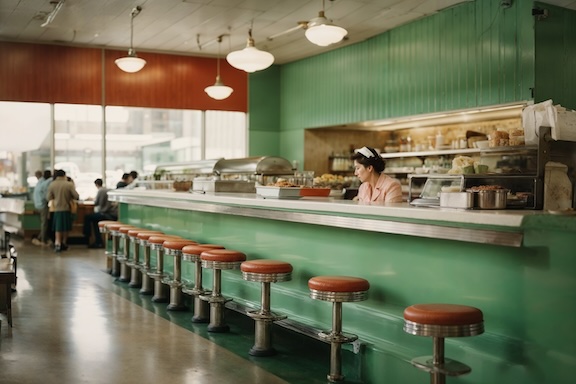The mid century department store lunch counter offered a glimpse into a bygone era of American social and food culture. The counters were more than just food service areas; they were a fast paced social hub where shoppers and friends would stop for a brief meal and conversation over a cup of coffee.
The coffee served at most lunch counters were straightforward and most importantly, affordable. A stark contrast to the varied and often gourmet offered today. Coffee was typically strong, served in basic mugs or cups, with the focus on providing a quick, energizing drink. The experience was less about the coffee’s intricacies and more about the convenience and social interaction it provided.
The staff at the lunch counters were adept at handling high volumes, ensuring that even a brief visit was worthwhile. Alongside coffee, the counters offered simple food items like sandwiches, soups, and pastries, emphasizing ease of preparation with a small staff and speedy service.
The atmosphere at these counters was casual yet inviting, with long counters lined with stools and occasionally a few tables. This setup provided a welcoming environment that was not overly luxurious, underscoring the primary focus on shopping. The coffee cups used were notably smaller than today’s standards, typically holding about 9 to 11 ounces (I did find one source that said they went down to 8oz).
In terms of how much a cup of coffee cost at these lunch counters was surprisingly affordable by today’s standards. In the 1950s and 1960s, it might cost between 5 to 25 cents, reflecting the economic conditions of the era. The concept of free or reduced-cost refills, though not universal, was relatively common, showcasing the value placed on customer service and the low cost of coffee production at the time.
With the advent of fast-food chains and specialty coffee shops, these traditional department store lunch counters have largely faded into history. They remain, however, a symbol of a simpler time in American retail and social life, contrasting sharply with today’s coffee culture that emphasizes a wide variety of types, flavors, and brewing methods in more upscale settings.
Please note that if you purchase from clicking on the link, some will result in my getting a tiny bit of that sale to help keep this site going. If you enjoy my work, perhaps you would consider donating to my daily cup of coffee, thank you.

